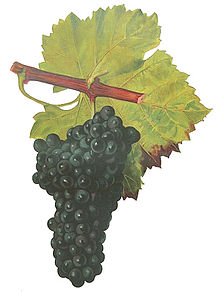Grolleau (grape)
| Grolleau | |
|---|---|
| Grape (Vitis) | |

Grolleau in Viala & Vermorel (as Groslot de Cinq Mars)
|
|
| Color of berry skin | Noir |
| Species | Vitis vinifera |
| Also called | see list of synonyms |
| Origin | France |
| Notable regions | Loire |
| Notable wines | Rosé d'Anjou |
| Hazards | wind damage inconsistent quality |
Grolleau or Grolleau noir is a red French wine grape variety that is grown primarily in the Loire Valley of France. The name is derived from the French word grolle, meaning "crow" and is said to reflect the deep black berries of the Grolleau vine. The grape is most commonly made into rosé wine, particularly in the Anjou region. Grolleau wines tend to low alcohol content and relatively high acidity.
The first documented plantings of Grolleau occurred in the Charente region in the early 19th century. Ampelographers believe that the grape is likely related to the ancient variety Gouais blanc. The Grolleau vine's greatest popularity occurred during the mid- to late 20th century with the widespread marketing of Rosé d'Anjou wine, of which Grolleau was the principal component. Often blended with Gamay, Grolleau-based Rosé d'Anjou was a sweet wine. Towards the turn of the 21st century, Rosé d'Anjou (and by extension Grolleau), started to fall out of favor in lieu of the Cabernet Franc and Cabernet Sauvignon–dominated rosé Cabernet d'Anjou. By 2000 there were only 5,500 acres (2,200 hectares) of Grolleau planted in the Middle Loire.
The decline has been attributed, in part, to Grolleau's reputation for poor quality as noted by wine experts such as Jancis Robinson and Tom Stevenson. Wine critic Robert M. Parker, Jr., has taken a dim view of Grolleau's potential, recommending in his wine buying guide that growers in the Loire Valley should rip up all Grolleau vines and replace them with grape varieties that have more potential for quality wine production such as Gamay and Cabernet Franc.
...
Wikipedia
